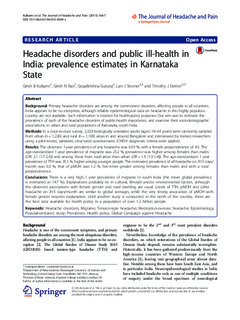Headache disorders and public ill-health in India: Prevalence estimates in Karnataka State
Journal article, Peer reviewed
Permanent lenke
http://hdl.handle.net/11250/2366229Utgivelsesdato
2015Metadata
Vis full innførselSamlinger
Sammendrag
Background: Primary headache disorders are among the commonest disorders, affecting people in all countries.
India appears to be no exception, although reliable epidemiological data on headache in this highly populous
country are not available. Such information is needed for health-policy purposes. Our aim was to estimate the
prevalence of each of the headache disorders of public-health importance, and examine their sociodemographic
associations, in urban and rural populations of Karnataka, south India.
Methods: In a door-to-door survey, 2,329 biologically unrelated adults (aged 18–65 years) were randomly sampled
from urban (n = 1,226) and rural (n = 1,103) areas in and around Bangalore and interviewed by trained researchers
using a pilot-tested, validated, structured questionnaire. ICHD-II diagnostic criteria were applied.
Results: The observed 1-year prevalence of any headache was 63.9 %, with a female preponderance of 4:3. The
age-standardised 1 year prevalence of migraine was 25.2 %; prevalence was higher among females than males
(OR: 2.1 [1.7-2.6]) and among those from rural areas than urban (OR = 1.5 [1.3-1.8]). The age-standardized 1 year
prevalence of TTH was 35.1 %, higher among younger people. The estimated prevalence of all headache on ≥15 days/
month was 3.0 %; that of pMOH was 1.2 %, five-times greater among females than males and with a rural
preponderance.
Conclusions: There is a very high 1 year prevalence of migraine in south India (the mean global prevalence
is estimated at 14.7 %). Explanations probably lie in cultural, lifestyle and/or environmental factors, although
the observed associations with female gender and rural dwelling are usual. Levels of TTH, pMOH and other
headache on ≥15 days/month are similar to global averages, while the very strong association of pMOH with
female gender requires explanation. Until another study is conducted in the north of the country, these are
the best data available for health policy in a population of over 1.2 billion people.
Keywords: Headache disorders; Migraine; Tension-type headache; Medication-overuse headache; Epidemiology;
Population-based study; Prevalence; Health policy; Global Campaign against Headache
